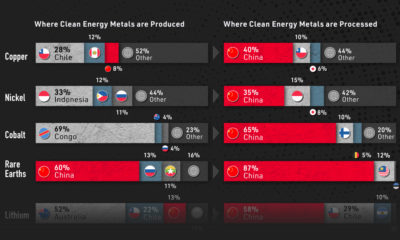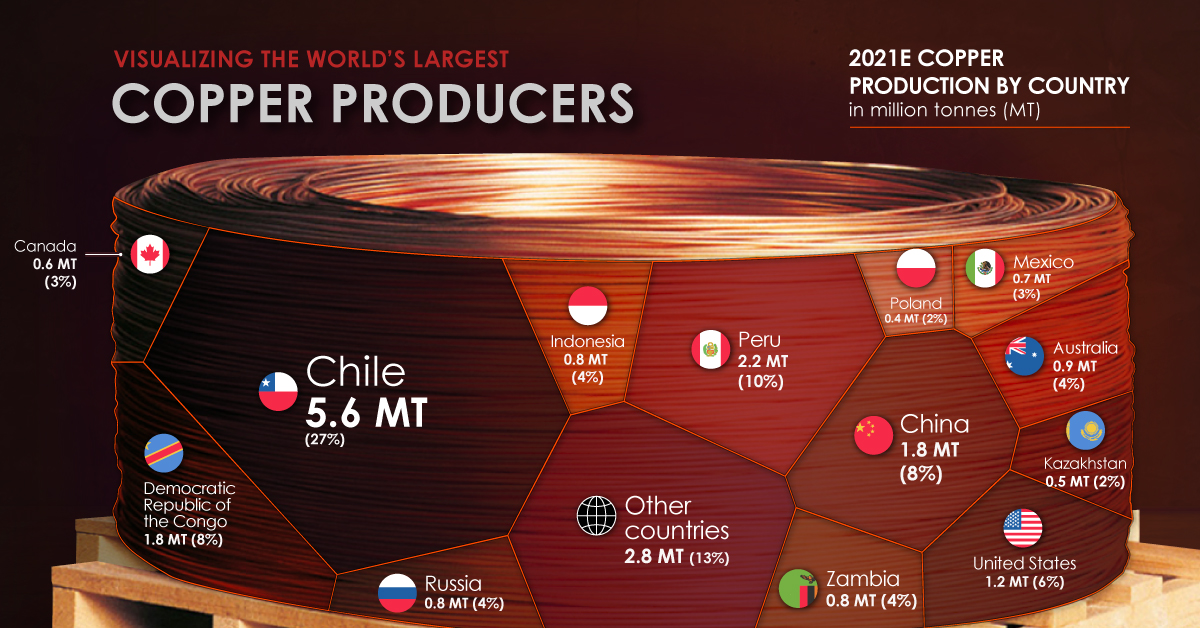Phones, cars, and computers might not seem like the most natural objects. But the metals that make them come from natural processes deep in the earth’s crust – processes that have been going on for 3.4 billion years, and continue to this day. Today’s visualization comes to us from Foran Mining Corp. and goes in depth to show how one type of mineral deposit, Volcanogenic Massive Sulphide or “VMS”, forms and is the primary source for many of the materials that make the modern world.
What is a VMS Deposit?
Volcanogenic Massive Sulphide (VMS) deposits are one of the richest sources of metals such as copper, lead, and zinc globally. VMS deposits can also produce economic amounts of gold and silver as byproducts of mining these deposits.
Currently, global metal production from VMS deposits account for 22% of zinc, 9.7% of lead, 6% of copper, 8.7% of silver and 2.2% of gold.
Where are VMS deposits found?
VMS deposits occur around the globe and often form in clusters or camps, following the tectonic plate boundaries in areas of ancient underwater volcanic activity. Natural processes underway today are forming the VMS deposits of tomorrow. This gives scientists an incredible advantage in witnessing how VMS deposits form and gives a special advantage to geologists for what to look for.
Mineralization and Formation
The geological processes that form VMS deposits occur at the depths of the ocean and are associated with volcanic and/or sedimentary rocks. At sections where the Earth’s crust is thin due to faulting or separation of tectonic plates, the magma heats up the ocean floor. As the Earth’s crust heats up, the ground softens and allows heated magma to escape towards the ocean or crust contact, the early beginning of a volcano and the deposition of minerals into the ocean floor from magma. Also, the heated ground cracks and begins a process that draws in sea water into the crust which becomes super-heated and imbued with minerals. Black and white smokers expel this seawater back to the surface. Black and white smokers exhale a mineral rich-plume that spreads out over the ocean floor. As it moves farther and farther away from its heat source, the plume precipitates minerals onto the ocean floor. Over time, the continual activity of the smokers and their mineral rich plumes create mineralized beds that become VMS deposits. With the movement of the Earth’s tectonic plates, these mineral rich beds are transposed and can be found on land that was once underwater.
How Big Can VMS Deposits Get?
Current resource and historical production figures from 904 VMS deposits around the world average roughly 17 million tonnes (“Mt”), of which is approximately 1.7% copper, 3.1% zinc, and 0.7% lead. A few giant mineral deposits (greater than 30 Mt) and several copper-rich and zinc-rich deposits of median tonnage (~2 Mt) skew the averages. Several large VMS camps are known in Canada, including the Flin Flon, Bathurst and Noranda camps. The high-grade deposits within these camps are often in the range of five to 20 million tonnes of ore and can be much larger. Meanwhile, approximately 90 VMS deposits have been discovered in the Iberian Pyrite Belt which runs through Portugal and Spain. Several of these are larger than 100 million tonnes, making this region one of the most significant hosts to VMS deposits in the world. on Man has relied on copper since prehistoric times. It is a major industrial metal with many applications due to its high ductility, malleability, and electrical conductivity. Many new technologies critical to fighting climate change, like solar panels and wind turbines, rely on the red metal. But where does the copper we use come from? Using the U.S. Geological Survey’s data, the above infographic lists the world’s largest copper producing countries in 2021.
The Countries Producing the World’s Copper
Many everyday products depend on minerals, including mobile phones, laptops, homes, and automobiles. Incredibly, every American requires 12 pounds of copper each year to maintain their standard of living. North, South, and Central America dominate copper production, as these regions collectively host 15 of the 20 largest copper mines. Chile is the top copper producer in the world, with 27% of global copper production. In addition, the country is home to the two largest mines in the world, Escondida and Collahuasi. Chile is followed by another South American country, Peru, responsible for 10% of global production. The Democratic Republic of Congo (DRC) and China share third place, with 8% of global production each. Along with being a top producer, China also consumes 54% of the world’s refined copper.
Copper’s Role in the Green Economy
Technologies critical to the energy transition, such as EVs, batteries, solar panels, and wind turbines require much more copper than conventional fossil fuel based counterparts. For example, copper usage in EVs is up to four times more than in conventional cars. According to the Copper Alliance, renewable energy systems can require up to 12x more copper compared to traditional energy systems. With these technologies’ rapid and large-scale deployment, copper demand from the energy transition is expected to increase by nearly 600% by 2030. As the transition to renewable energy and electrification speeds up, so will the pressure for more copper mines to come online.












